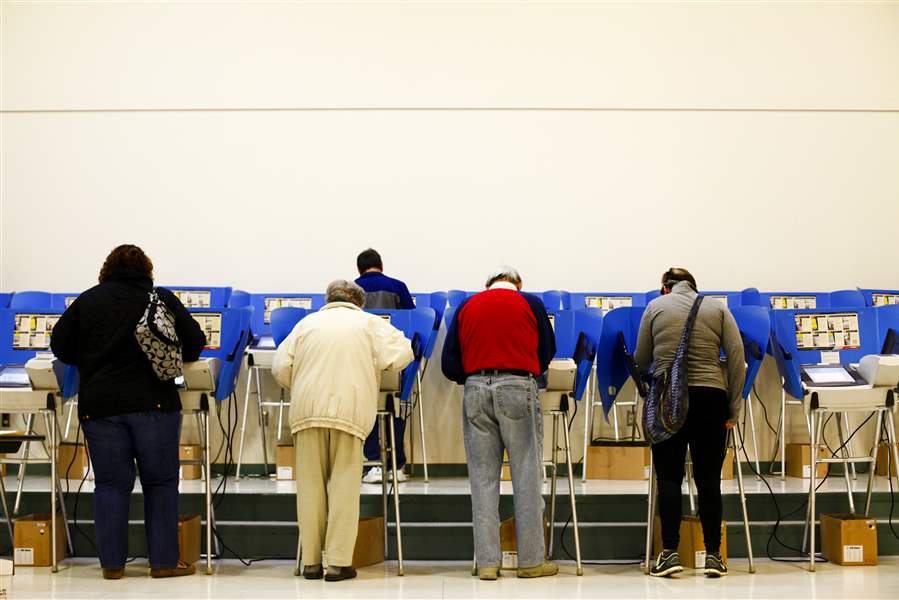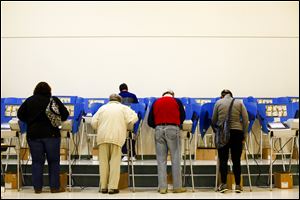
Turnout dives over course of city’s strong-mayor setup
11/7/2013
People cast their ballots, Tuesday, November 5, 2013 at the Rossford Board of Education Bulldog Hall in Rossford.
THE BLADE/JEFFREY SMITH
Buy This Image

People cast their ballots, Tuesday, November 5, 2013 at the Rossford Board of Education Bulldog Hall in Rossford.
Twenty years after Toledo launched the strong-mayor form of government, Toledo voters seem to be gradually losing interest.
The total votes cast in Toledo’s mayor race this year — 49,538 — is a little more than half the total votes cast in the first strong-mayor election in 1993, 92,470.
And unlike 20 years ago, voters in this election had 30 days before Election Day to cast an early ballot in person or mail in a “no excuses” absentee ballot.
Independent D. Michael Collins, a South Toledo councilman who surged from behind in the Sept. 10 primary, defeated incumbent Mayor Mike Bell, also an independent, by 57 to 43 percent of the vote. The total turnout compared with 68,845 voters four years earlier.
Mayor-elect Collins said, “I was hoping that there would have been a greater turnout.
RELATED LINK: Blade database of election results
RELATED LINK: Councilman Collins sets his sights on transition to mayor
“I’m just very hopeful that from here on out we can generate a greater interest in council and mayor elections because it certainly shows the community is somewhat apathetic,” Mr. Collins said.
Mayor Bell was not available for comment.
Political experts cited as a likely key reason for the lower turnout the lack of an endorsed candidate from the dominant Democratic Party.
“It’s sad,” said Republican City Councilman Rob Ludeman, the top vote-getter Tuesday in the council election race. “There’s no excuse not to vote. I knew I was going to be re-elected. I would rather be re-elected with a larger percentage of the voters.”
He said the election proved once again the strong voting participation in South Toledo. Wards 15, 16, 7, and 24, stretching from the Toledo Zoo to Southwyck, were among the city’s highest voting wards.

Where they vote

On Tuesday, turnout varied by ward, with larger numbers of voters casting ballots in far West and South Toledo than in the central city.

The ward with the largest number of votes was 23, an area northwest of Laskey and Douglas roads, and including Trilby. Ward 23 reported 3,642 votes, with a turnout of 32 percent.
The ward with the fewest voters was Ward 2, with 688 voters — less than one-fifth the number of voters in Ward 23.
Ward 2 is north of Cherry Street, between the Maumee River and the Greenbelt Parkway and a part of the Lagrange neighborhood.
Wards are drawn based roughly on population but cannot account for wide variations in the level of voter interest.
Ward 23 is the center of what Toledo politicians for decades have called the “fertile crescent” — a stable area of middle-class home owner-occupants. Ward 2, by contrast, is more significantly low-income, with more renters and transient residents.
Mayor Bell outpolled Mr. Collins in all the wards with significant numbers of African-Americans — 4, 6, 8, 10, 12, 13, and 14. But relatively low turnout in most of those wards contributed to Mr. Bell’s lopsided defeat. The exception was Ward 12, which includes Mr. Bell’s home neighborhood of Old Orchard, which had a turnout of 2,596 voters, or 29 percent.
Candidate outreach
Voter participation has declined markedly since 1993, when Democrat Carty Finkbeiner defeated independent Mike Ferner. There were 91,711 votes for mayor in 1997, 78,994 in 2001, 79,012 in 2005, and 68,845 in 2009.
According to county records, Lucas County had 247,882 registered voters in 1993, compared with 311,647 at present.
Evan Watkins Morrison, a member of the Lucas County Democratic Party Executive Committee and a political operative who worked for failed primary mayoral candidate Joe McNamara, said the decline in voter participation puts a responsibility on candidates.
“People aren’t getting involved not because they don’t have ideas. They see such stasis that they have other things to do with their time,” Mr. Morrison said. “We as people who work on campaigns need to work a lot harder at speaking clearly and succinctly and engaging people.”
Lucas County Republican Chairman Jon Stainbrook said “voter apathy” was the explanation for the shrunken turnout.
“There was no one at the top of the ticket for the mayor’s race and the top of the ticket is what draws out the people,” Mr. Stainbrook said. He said voters are upset with what’s going on in Washington.
“They feel like what’s the point?” Mr. Stainbrook said.
Toledo Councilman-elect Jack Ford, who is a veteran of city elections, said factors included the lack of a Democratic candidate for mayor and an apparent lack of exciting candidates.
“The Democratic Party didn’t have the apparatus to get out the vote. It might have been just too low-key,” Mr. Ford said, adding, “We don’t have ward-precinct operations getting out the vote in the neighborhoods in the Democratic Party like we used to.” He said having operatives in the neighborhoods calling people on Election Day to remind them to vote is an important element in boosting voter participation.
The Democratic Party had no endorsed candidate for mayor for the first time in modern history, after the two Democrats in the primary, Councilman McNamara and Lucas County Auditor Anita Lopez, split the Democratic vote. Turnout in that election was just over 15 percent, which prompted an effort after the primary among some Democrats to demand more outreach by the Lucas County Democratic Party. Executive Director Yvonne Harper resigned but then was invited back by Chairman Ron Rothenbuhler a week later.
Neither candidate for mayor ran with a party label, leaving the parties to focus on down-ticket races, such as council and school board.
One down-ticket race that still could change is that of the sixth finisher for six council at-large positions. Democrat Adam Martinez finished only 39 votes ahead of unendorsed Democrat Larry Sykes.
There are still 595 provisional ballots remaining to be validated and counted. The ballots will be counted after 10 days. Provisional votes tend to be heaviest in the central city, where Mr. Sykes outpolled Mr. Martinez, leading to speculation that the provisional votes could make Mr. Sykes rather than Mr. Martinez the winner of the sixth at-large seat.
The county was not immune from voter indifference. Participation was 19 percent in Sylvania city and township, 22 percent in Washington Township, and 24 percent in Springfield Township.
Countywide, the turnout percentage was highest — 41 percent — in the small township of Spencer, where voters decided to withdraw from TARTA.
Turnout was also high in Oregon, at 5,283 votes or 37 percent, where voters had a lively mayoral contest as well as a vote on a new city levy, which passed.
Contact Tom Troy: tomtroy@theblade.com or 419--724-6058 or an Twitter @TomFTroy.